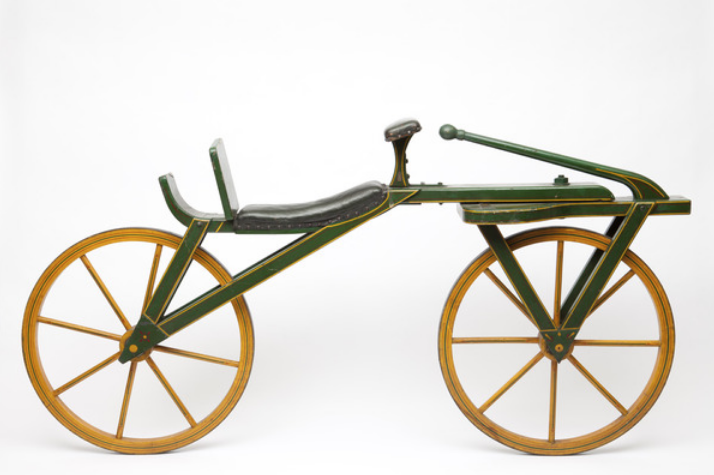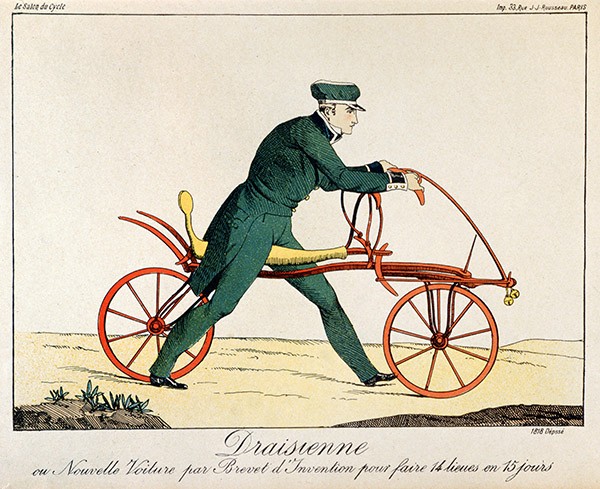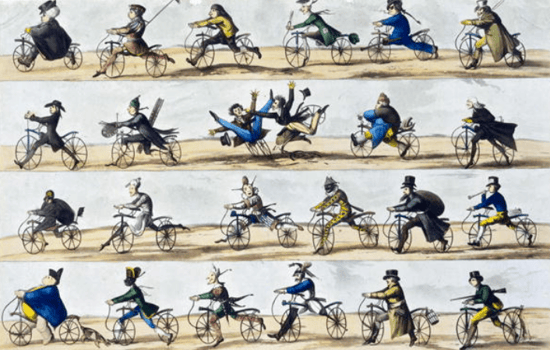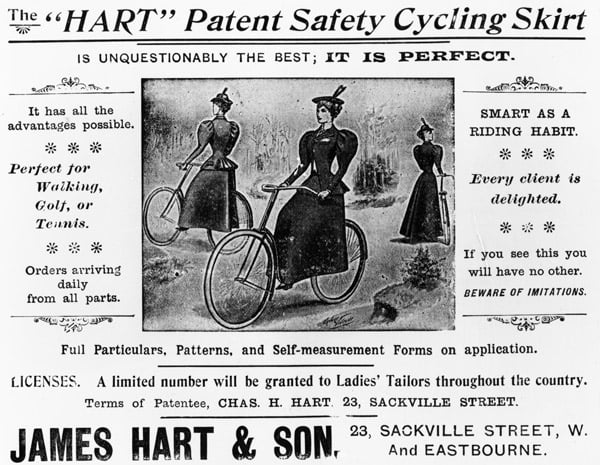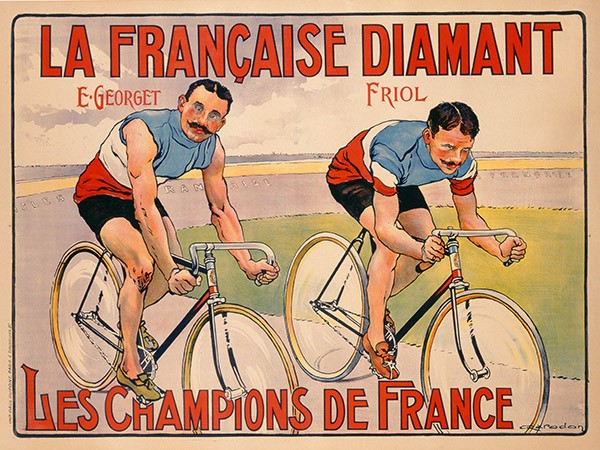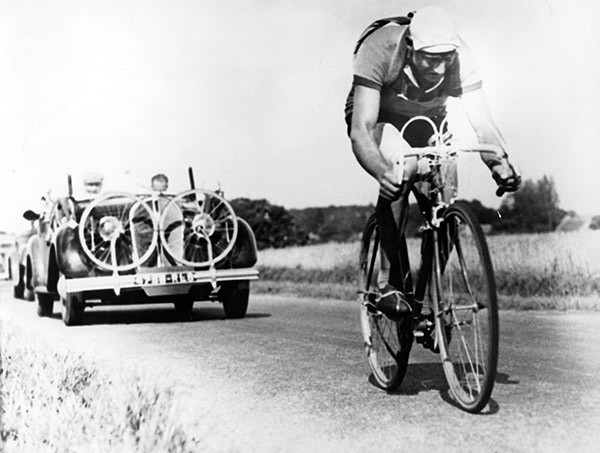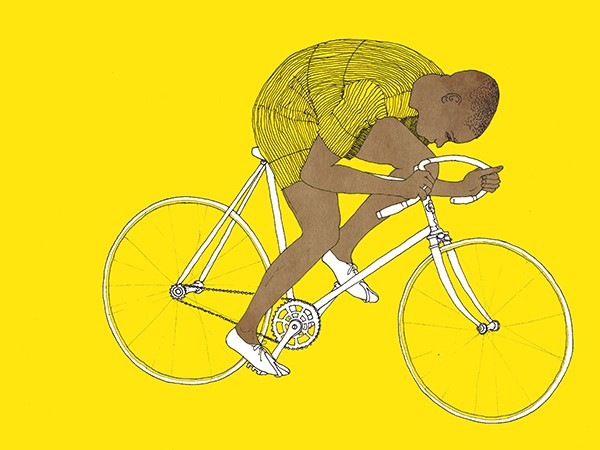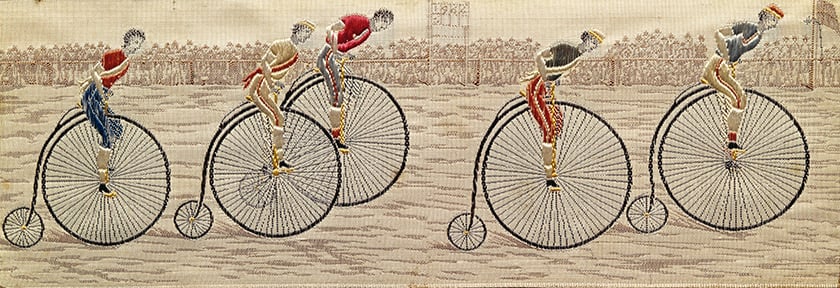
The Evolution of the Bicycle
According to some historians it is almost 200 years since the first documented bike ride by Karl von Drais in 1817 and the city of Mannheim in Germany is planning to celebrate this bicentenary with a major exhibition. The answer to the question of who invented the first bicycle often depends upon the nationality of who you ask as over the years many people have contributed ideas and developments.
Let’s take a look at the evolution of the bicycle, showing the craze for cycling is nothing new.
1493: the Earliest Bicycle Sketch…
It has been said that Leonardo da Vinci was the first person to ever visualise the concept of a bicycle but was unable to construct it. News of a bicycle-like sketch is said to have been discovered during the ten-year restoration period of the Codex Atlanticus in the 1970s that had not been seen for 500 years.
Since 1998, Hans-Erhard Lessing, a Professor of Physics, has claimed it a fraud and leans towards the more popular opinion that the bicycle originated in the 1800s in Germany.

Left: Da Vinci (1452-1519) Codex Atlanticus detail
Right: Reconstruction of da Vinci’s design for a bicycle
1817 to 1819: the Draisine
In 1817, Baron Karl Von Drais of Germany designed and built a two-wheeled, wooden vehicle that was straddled and propelled by walking swiftly. Invented to fill the need for horseless transport during a shortage of oats, Von Drais called it the laufmaschine or “running machine.”
Constructed almost entirely of wood, the draisine weighed 22 kg and had no pedals but what it lacked in practicality, it made up for with speed. On its maiden voyage, the bicycle covered 13 kilometres in less than an hour. Unsurprisingly, the following year, 1818 saw the Baron obtain a patent, inspiring manufacturers from other parts of Europe to create their own contraptions, calling them “dandy horses.”
1819: the Hobby Horse
Denis Johnson made refinements to this model and during the summer of 1819 the “hobby-horse” became the craze and fashion in London society. Several parts were made of metal, which allowed the vehicle to be lighter than the continental version.
1860s: the Boneshaker Era – now with pedals
Many historians credit Pierre and Ernest Michaux as being the true inventors of the modern bicycle. This father and son duo operated a company that made carriages in Paris where they first assembled a two-wheeled velocipede around 1867. This bike was was propelled like a tricycle, with its cranks and pedals connected to the front wheel.
The design soon came to the U.S. when a Michaux employee named Pierre Lallement who also claimed credit for the idea, saying he developed the prototype in 1863, set out for America.
In England, the velocipede earned the name of “bone-shaker” because of its rigid frame and iron-banded wheels that resulted in a “bone-shaking experience for riders.”
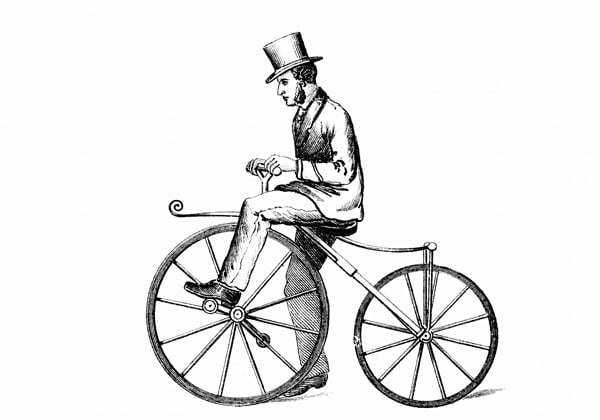
The Boneshaker, the type of pedal-driven bicycle popular c1870. Wood engraving c1880.; Universal History Archive/UIG
Mid-1870s: the ‘High Wheel’ era
‘Penny-farthing‘, ‘high wheel’, ‘high wheeler’, and ‘ordinary’ were all terms used to describe a type of bicycle with a large front wheel and a much smaller rear wheel that was popular after the boneshaker. They were the first machines to be called “bicycles.”
Although this trend was short-lived, the penny-farthing became a symbol of the late-Victorian era. The dangerous nature of these bicycles made cycling the preserve of adventurous young men and its popularity also coincided with the birth of cycling as a sport. The risk averse, such as elderly gentlemen and ladies, preferred the more stable tricycles.

Left: Tom Monagan, Dallas Historical Society,Texas, USA
Right: The Cripper tricycle introduced in 1887. Engraving 1887.
1871: the First Geared Bike
In 1871 James Starley invented the Ariel which was probably the first geared bike.
1888: the Pneumatic Tyre
John Boyd Dunlop was a Scottish vet living in Belfast. His son complained that when he rode his bicycle to school the cobbled streets made his bottom sore. Dunlop solved his son’s problem by inventing the inner tube and patented the pneumatic tyre which was essentially a hosepipe inside an outer rubber tyre with treads. But the patent was reversed two years later because of a previous patent by Scottish inventor Robert William Thompson.

Left: A garden hose provided John Dunlop with a smooth bicycle ride © Look and Learn
Right: Page of Advertisements (engraving) by English School, (19th century) Private Collection © Look and Learn / Illustrated Papers Collection
1890’s: the Safety Bicycle
The term safety bicycle was used in the 1880s for any alternative to the penny-farthing and caused a bike boom due to being lighter, less expensive and easier to ride. Unlike with penny-farthings, the rider’s feet were within reach of the ground, making it easier to stop, greatly diminishing the danger of “taking a header” or long fall over the handlebars. The impact of the bicycle on female emancipation was huge and came to symbolise the New Woman, central to the “rational dress” movement of the late nineteenth century.
1890’s: the Tandem
The two-wheeled “safety bicycle” configuration that we recognize today as a tandem seems to show up in the early 1890’s. Many of the early tandems were “courting bikes” designed for a man and woman which placed the lady in the front seat with the man behind and steering the bike through a linkage from the rear position. Tandem popularity began to decline after WWII until a revival started in the late sixties.
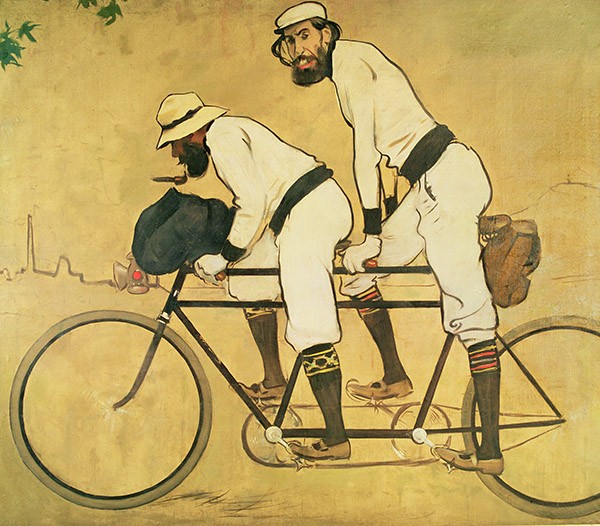
Self Portrait of Casas with Pere Romeu on a Tandem, 1897 by Ramon Casas i Carbo (1866-1932) Museu d’Art Modern, Barcelona, Spain
Mass Production
The 1890’s is often referred to as the Golden Age of bicycles and it was during this decade that some of today’s popular bicycle manufacture companies were set-up. Both Raleigh and Schwinn were founded, increasing the availability of the bicycle.
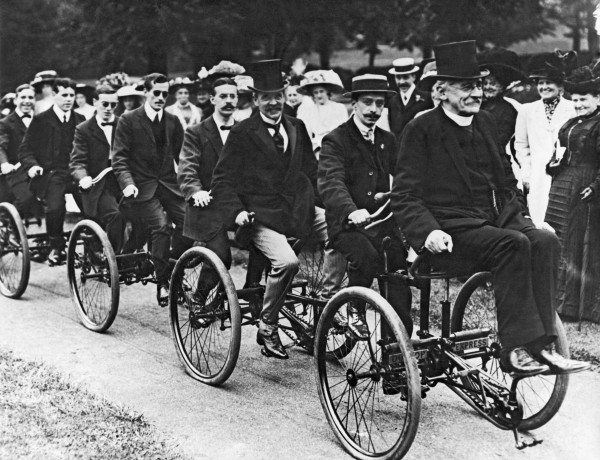
Rush Hour Bicycle Commute in England: c. 1900. Pedaling a vehicle called the Dunlop Express (b/w photo) / Underwood Archives
1900’s: Bicycle Racing Takes Off
Interest in bicycle racing grew in proportion to its great rise in general popularity, and so it was only natural that bike racing was included as one of the events in the first modern Olympic games in 1896. The first Tour de France was held in 1903 as a promotional event for L’Auto, a French newspaper. Sixty cyclists set out to compete in the first Tour, and only 21 finished. Maurice Garin, aka the Little Chimney-Sweep, won the day on this steel La Française. His heavy frame featured new-fangled toe clips—invented only a few years prior.
1930’s: Taking it Up a Gear
The derailleur was developed in France in the early 20th century but was introduced in the Tour de France for the first time in 1937. Before that, riders were forced to use a two-speed bicycle and would have to get off to switch gears. Derailleurs did not become common road racing equipment until 1938 when Simplex introduced a cable-shifted derailleur.
1980s: the Mountain Bike
There was a bike boom in the mid 1970s in America as a solution to petrol prices making the automobile use prohibitive, followed by a period in which sport bicycles were the focal point of design. In the 1980s cyclists began to shift from road-only bicycles to all-terrain models. Mountain bikes and the BMX became popular, introducing multiple gears and much lighter construction frames.
21st Century: Bikes for All
While the basic frame design has stayed the same for over a hundred years, the use of space age material like titanium and carbon fiber have created bikes far lighter and stronger than creators of the early iron and wooden models could ever have imagined.
Bike styles have morphed too, to allow the incorporation of design features that specifically enhance one particular style of riding to the exclusion of others. This specialization means that you can go into any given bike shop and select from mountain bikes, road bikes, hybrids, cruisers and more, all based on where and how you plan to ride.
Bicycle Culture: the New Cycling Revolution
Increasing numbers of us are getting out of our cars as bicycle culture is taking hold with more of us conscious of reducing our carbon footprints and keeping fit. Most of us grew up riding bicycles for fun but it is only relatively recently that they are becoming our most popular form of transport.
U.S. Census data suggested a 60% increase in bicycle commuting between 2000 and 2012. Middle-Aged Men in Lycra (MAMILs) have also rapidly become a cultural phenomenon kitted out in garish sponsor-laden kits of professional teams pedaling away on £4,000 bicycles.
“Life is like riding a bicycle. To keep your balance, you must keep moving.” Albert Einstein
Images & Licensing
Please contact the Bridgeman team for further enquires regarding licensing images and clips
View more cycling images and footage
Save

